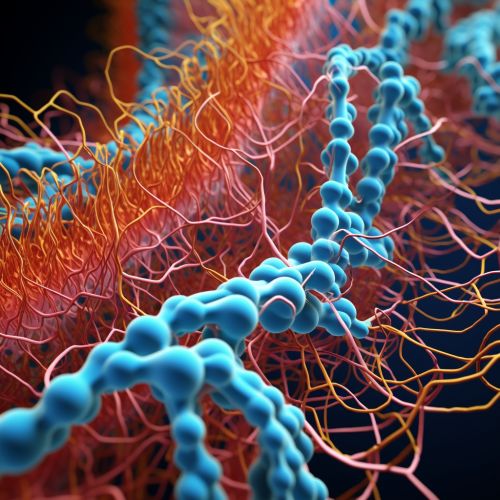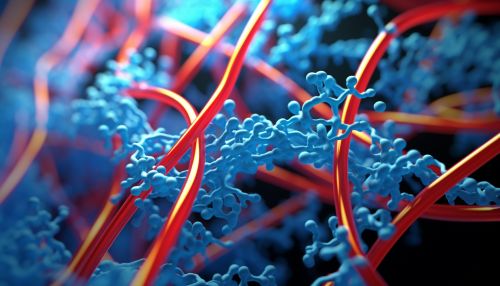Chromatin
Introduction
Chromatin is a complex of deoxyribonucleic acid and proteins that forms chromosomes within the nucleus of eukaryotic cells. Its primary function is to package long DNA molecules into a more compact, denser shape, which prevents the strands from becoming tangled and plays important roles in reinforcing the DNA during cell division, preventing DNA damage, and regulating gene expression and DNA replication.


Structure
Chromatin is composed of repeating units called nucleosomes, which are DNA wound around eight histone proteins. The DNA double helix is wrapped around these histone proteins at intervals of about 200 base pairs. Each nucleosome is separated by a short stretch of DNA called linker DNA.
Histones
Histones are proteins that have a high content of basic amino acids, are positively charged, and are abundant in lysine and arginine residues. The positive charge of the histones forms an ionic bond with the negatively charged phosphate groups on the DNA backbone. The basic unit of chromatin organization is the nucleosome, which consists of the core histones H2A, H2B, H3, and H4.
Nucleosomes
The nucleosome is the fundamental subunit of chromatin. Each nucleosome is composed of a little less than two turns of DNA wrapped around a set of eight proteins called histones, which are known as a histone octamer. Each histone octamer is composed of two copies each of the histone proteins H2A, H2B, H3, and H4.
Function
Chromatin serves to package DNA into a smaller volume to fit within the cell, to strengthen the DNA to allow mitosis and meiosis, and to serve as a mechanism to control expression and DNA replication. The structure of chromatin networks is currently the subject of intense study and is considered to play a key role in influencing the patterns of DNA folding and the frequency of interaction between different loci on the DNA.
Gene Regulation
Chromatin plays a crucial role in gene regulation. The accessibility of the DNA to the transcription machinery, i.e., the proteins involved in the process of transcription, determines whether a particular gene is expressed or not. This accessibility is largely defined by the chromatin structure. The compact, dense nature of heterochromatin, for example, makes it difficult for the transcription machinery to access the DNA, thereby repressing gene expression.
DNA Replication and Repair
During the process of DNA replication, chromatin undergoes massive structural reorganization to allow the replication machinery access to the DNA. Similarly, in response to DNA damage, chromatin structure is dynamically altered to allow access to the DNA repair machinery.
Types of Chromatin
There are two types of chromatin: euchromatin and heterochromatin.
Euchromatin
Euchromatin is the less compact DNA form, and contains genes that are frequently expressed by the cell. These regions are rich in gene concentration, and are often (but not always) under active transcription. Euchromatin comprises the most active portion of the genome within the cell nucleus. 92% of the human genome is euchromatic.
Heterochromatin
Heterochromatin is the more densely packed form of DNA, which consists of DNA sequences that are often repetitive and not transcribed. Heterochromatin can be further divided into two types: constitutive and facultative. Constitutive heterochromatin can affect the genes near itself and is often found around the centromere and telomeres of a chromosome. Facultative heterochromatin is the result of genes that are silenced through a process called methylation.
Chromatin Remodeling
Chromatin remodeling is the dynamic modification of chromatin architecture to allow access of condensed genomic DNA to the regulatory transcription machinery proteins, and thereby control gene expression. Such remodeling can be accomplished through covalent histone modifications, ATP-dependent chromatin remodeling complexes, and DNA methylation.
